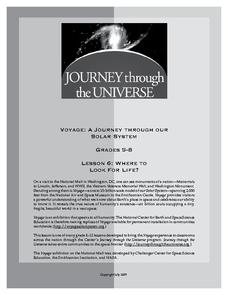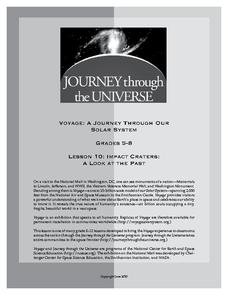American Battle Monuments Commission
Honoring Service, Achievements, and Sacrifice: A WWI Virtual Field Trip
The largest offensive in United States military history comes alive in a online interactive resource. Young historians explore the Meuse Argonne battlefield and scour the landscape for evidence from the battle. They then use primary...
Curated OER
Civil War Documents In Brooklyn
Young scholars investigate the use of monuments and why they are important for the study of history. They conduct research using a collection of primary sources. Students write a report about the information they find and present it to...
Curated OER
Maya Lin
Students are able to explain the important contribution Maya Lin made to society, write about their definition of a hero, and recognize, appreciate and describe the significance of memorials.
Curated OER
Honoring the Veterans of WWI
Young scholars raise money for a memorial. In this community service lesson, students support the building of a memorial for WWI veterans in Washing D.C. Young scholars educate their community about the memorial, raise funds, and explore...
PBS
Act of Duty
PBS provides educators with this "Utilization Guide," a four segment program that covers the Civil War, World War I, World War II, the Korean conflict, Vietnam, and the Gulf War. The 42-page packet includes lessons, background...
National First Ladies' Library
Lawnfield and Other Ohio Presidential Homes
High schoolers investigate the residences of presidents found in the state of Ohio. They conduct research in the internet and also looking for buildings dedicated to the memory of presidents. The information is used in order to create...
Curated OER
Touchstones
Young scholars locate monuments in their neighborhoods and sketch them. They are shown slides of two modern monuments, the Vietnam Memorial and the Holocaust Monument in Edgewood Park. They read the article in National Geographic, Vol....
Curated OER
Madrid Train Bombings
Students discuss the terrorist train bombings in Madrid, Spain. The class evaluates the value of memorials in the struggle to deal with the grieving process. Groups design a memorial and/or poem to commemorate those lost in the...
Curated OER
Historic Takes
Students examine photographs of memorials for veterans. They identify who is being honored and why. They research one hero they find interesting and create a memorial for them. They share their hero with the class.
Curated OER
Remembering Logan Fontenelle
Students research Logan Fontenelle and discuss his role in history and importance to the state of Nebraska. Students create individual mock memorials for Fontenelle to be placed at his burial site.
Curated OER
Symbols of America
Students research the events of September 11th . In this symbols lesson, students discover ways to honor this day. Students research the Internet for symbols used to represent ideas, events and people. Students work in groups to design a...
Curated OER
Washington, D.C.
In this Washington, D.C. worksheet, students complete 6 pages of readings and questions about Washington, D.C. Included are general facts, geography, monuments, history, economy and people. There is a short text and 6 multiple choice...
Curated OER
Burial Practices and Memorials
Young scholars compare and contrast burial practices in ancient Egypt, the former Soviet Union, and the United States.
Overcoming Obstacles
Setting Expectations
As Don Quixote asserts in the musical Man of La Mancha, it is possible to achieve your dreams. For the last lesson plan in the Getting Started Module, participants learn the importance of having dreams and setting goals that help them...
Academy of American Poets
Teaching the Vietnam War with Poetry and Archives
The language of and the perspective of photographs, poems, and official reports differ. After a close reading of two photographs, two poems, and a military report about the Vietnam War, individuals adopt someone's voice or something from...
Curated OER
Man's Continuing Inhumanity to Man
Students explore social justice issues. In this human justice lesson, students examine the meaning of words associated with minority groups and investigate genocide throughout history.
Curated OER
Ancient Chinese Tomb Building
Young scholars compare and contrast the monuments erected for George Washington, the first president of the United States, and Qin Shi Huangdi (r. 221- 210 BCE), the first emperor of China. This lesson also includes a creative project.
Curated OER
Patriotic Symbols
Students define what a patriotic symbol means, as well as sing a patriotic song. In this social science lesson students work in groups to write about a patriotic symbol. Groups draw pictures of their symbols.
Curated OER
Vetern's Day, A Chance to Honor Those Who Served Our Country
Students examine some of the symbols, songs, and pledges that represent our country as well as the liberties they enjoy today due to those who served. They discuss the rules for displaying the United States Flag, practice folding the...
Curated OER
The History of Art
Teachers can use these art history lesson plans as a way to get students to look at art in a new light.
Journey Through the Universe
Voyage of Discovery
Did you know that Pluto is smaller than the United States of America? It is difficult to conceptualize the size of planets and the distance between them, and the lesson addresses those exact issues. After a discussion, pupils create...
Journey Through the Universe
Where to Look For Life?
Every year we discover new planets including more than 1,000 in 2016 alone. Will we ever find life on another planet? The lesson includes two activities to help scholars understand this concept. First, they analyze the temperature range...
Journey Through the Universe
Is There Anyone Out There?
What is an alien's favorite game? All-star baseball! Scholars start defining living and non-living. Then, they conduct experiments to research if life exists, keeping in mind that life could be in many forms, not just human.
Journey Through the Universe
Impact Craters: A Look at the Past
The Galle crater on Mars is also known as the Happy Face crater because of its appearance. First, scholars use pebbles and flour to simulate craters and study their properties. They then apply this knowledge to help decipher the history...

























